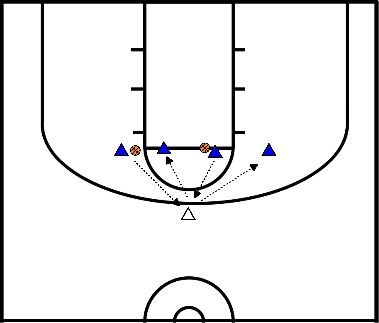Basketball drills for technique passing
Create a rectangular fieldTwo
teams: attackers / defenders
Players may only tap by pressing the ball on their backs
Learning point: quick passes move after your pass tight passes and quick passes
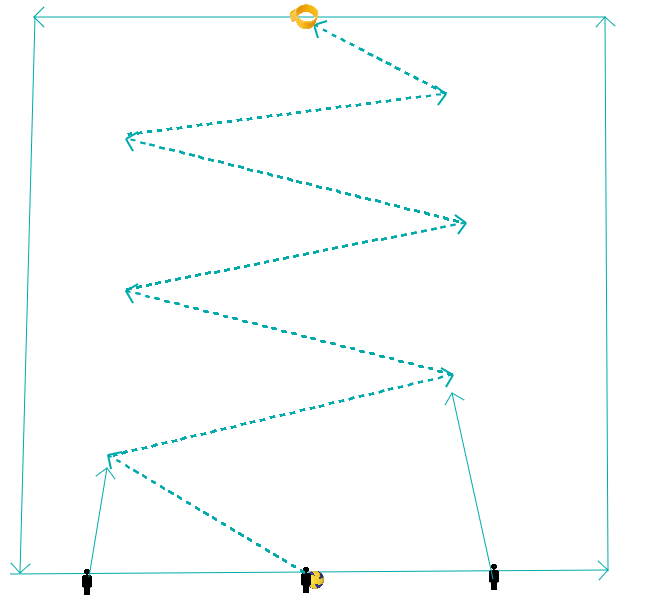
With 3 men on the back line and the middle one has the ball- The middle passes to a man and runs after the ball
- The man in the middle passes to the man on the other side, who also runs after the ball.
- They do this while running to the basket on the other side.
- When someone is close enough to the basket, the man runs a lay-up.
- He becomes the defender and the other two attackers must try to reach each other with a long ball.
- The goal of the defender is to prevent the attackers from scoring.
- If the attackers do not manage to score, they must do 5 push-ups.
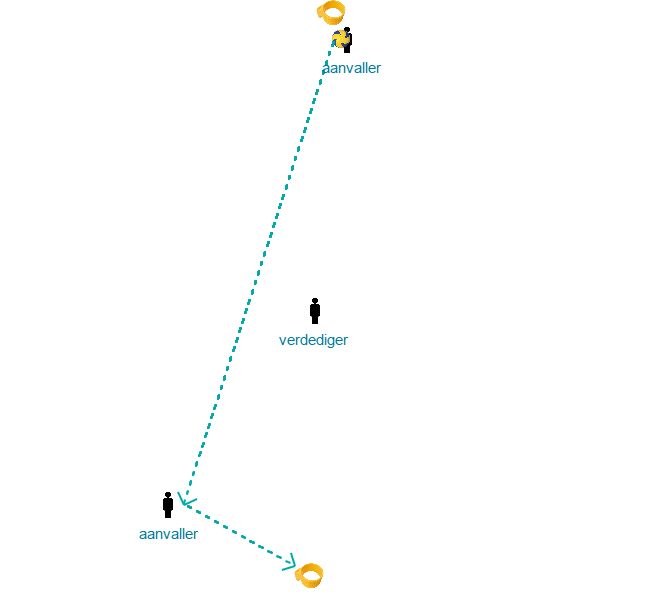
Objective:
Try to score 5 times with your group as quickly as possible.
Task:
Divide the players into 2, 3 or 4 groups so that there are max. 6 of them in a group. Give each player in each group a number from 1 to 6. Each group sits in a corner of the terrain. In the middle there are 2, 3 or 4 basketballs in hoops.
When the coach says a number, the players with that number sprint to the middle as fast as they can, take a basketball and dribble to goal. They get only 1 attempt to score. After their goal attempt, they put the balls back in the middle and rejoin their group. The first group with 5 scores wins the game.
Variations/ gradations
Make scoring easier by attaching a hoop to the ring where players can also score. A score through the hoop is then worth double points.
- Guards + Forwards + Centers
- from U14 - 6 to 12 players
- 4 balls
- whole field
- 2 baskets
Objective:
- Pass on the flyer training and finishing at full speed
- Players 1 and 4 receive the ball at the outlet position and dribble directly to the centre circle.
- passer sprints along the sideline (flyer)
- receives the ball at full speed
- makes the lay up without a dribble
Teaching Points:
- dribbler is not allowed to cross the centre line
- the pass should be such that the flyer can finish without dribbling
- The flyer must ask for the ball with his hand
- execute at full speed
- communication: outlet calls
- after the lay up join the line near the basket where you scored
- the dribbler returns directly to the outlet after the pass and for the next ball
Variations:
- (to teach the attacker to finish at full speed under pressure)
- Have a defender walk up to the attacker during the layup to distract him visually (no physical contact).
- make the defender appear bigger with a mat or similar in his hands
- Centers + Guards + Forwards
- from U12 - 2 or more players
- 1 ball per pair
- two baskets
- a pawn or pole
Prerequisites:
being able to run a layup from the pass at speed
Objective:
- train runner flyer
- Passing and catching at speed
Organization
- player 1 throws the ball against the board and catches the rebound
- catches the ball as high as possible
- 3 sprints to the outlet position and calls
- pass with an overhead pass to the outlet
- the man with the ball dribbles as fast as possible to the bucket of the other basket.
- defender sprints along the sideline
- receives the pass at full speed
- and makes the lay up without dribbling
Teaching Points:
- sprinting Â- communication
- correct dribble start
- pushing the ball at speed dribble
- The dribbler must see where the flyer is.
- pass in time
- Shooter catches his own ball
- passer sprints around the pawn
- calls
- receives the ball at the outlet position with an overhead pass
- both players run the same 2 teg
Two players throw the ball to each other, the ball may bounce. To make it more difficult the bouncing can be omitted. Also vary the distance.
The players stand in a circle and throw the ball to each other. They are not allowed to touch the ground. Try this with a player in the middle who is trying to intercept. If the ball is intercepted, the player who threw the ball stands in the middle.
There are rows of players on both sidelines.
- The front player of each row has a basketball.
- These players dribble to the sideline on the other side and play the ball with a bounce pass to the second player in the row who is now automatically in front.
- The first player closes in behind and the second player now dribbles across.
The players practice with the overhead pass (with 2 hands, from above the head) and vary the distance players stand in a circle with 1 player in the middle.
- One player starts and throws the ball with a chest pass to the player in the middle.
- Then the first player runs after the ball to the middle.
- The player in the middle throws the ball to the next player in the circle and then runs after them etc.
The players stand in a circle and pass the ball to each other.
- They are free to choose who they throw to and which pass variant they use.
- To make the exercise more difficult more basketballs can be used.
Emphasis can be placed on different fundamental items. Passing, ball handling, transition or shooting. You can
give it a conditional character for the core of your training.
The exercise is also fairly complex, which means that the players also have to think a little during the exercise (brain training).
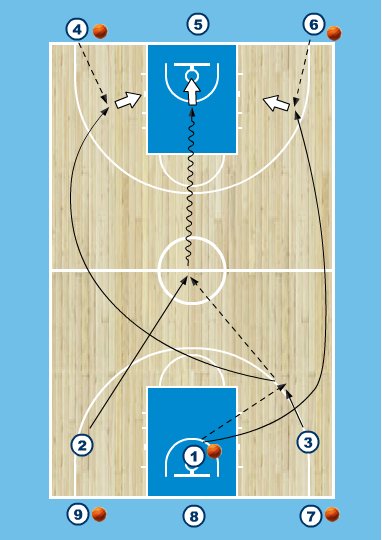
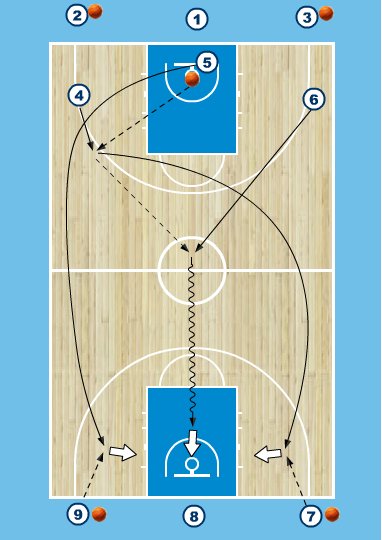
- The exercise starts with a plurality of 3 players.
- Even if you don't have a plural of 3, the exercise is possible, only then one player steps out each time. #1/#2/#3 start the exercise with a half weave to the center line.
- After his pass #1 becomes a flyer and after the pass from #3 he also becomes a flyer. #2 receives the ball last and dribbles midcourt for a score (lay-up).
- #3 and #1 receive the ball from #4 and #6 for the shot from outside. #5 rebounds the ball from #2, and starts the same drill along with #4 and #6.
- In this way this exercise repeats itself and a full court continuous drill is created.
Variations:
- The ballhandler (#2 in the first diagram) must finish with at least 1 change of direction (spindribble, reverse dribble, crossover, etc)
- Give the ballhandler a maximum number of dribbles so that he finishes aggressively.
- Have the 2 flyers who receive the ball stop with a jump stop / rhythm stop / or take 1 dribble and pull-up.
- Have the 2 flyers make a jab step with a countermove
- Starting with a rebound situation, you can vary with #1 / #2 / #3 in a row and throwing the ball up against the board (tipping), or have two players start at the board where one defends the outlet pass.
- The disadvantage of this is, that you have to constantly reorganize, and the continuous nature of the exercise disappears.
- Have #2 (in the first diagram) defend the ballhandler with a close-out and box out after the score or goal attempt.
- The 2 flyers make a "split the post" move, so they make a front move and cut in on the other side.
- This is a very good variation in terms of timing, as it involves three players.
Teaching points:
- Require the tempo you want from the players. Depending on the age, the exercise should reflect what you want to train. Keep in mind that the organization is quite complex, so for younger ages you will spend a lot of time on "organizing" the drill. So, wasted time, and ask yourself if you have this time.
- Make good stops, when catching the ball (flyers). Be critical on running, see that players make a stable stop, bring butt back, and jump straight up. The shot starts with the “foundation†and that is the footwork. If that is not right, it will affect all of your shot.
- Ballhandler finished hard on the basket. Re-enact the game situation! The attacker must visualize the defender. So dribble with the right hand (your body between the ball and the defender), protect the ball, also in 2T rhythm.
- Also use a situation where the ballhandler is the "front man" of the pitch, and therefore has to finish with a speed dribble: high, forward dribble, push the ball in front of you, and as few dribbles as possible (every dribble is a risk).
- Passing: Think about a good passing technique and its teaching points: Pass in front of the man, ask, make eye contact, target as a receiver, run into the ball, pass tightly, arms out, thumbs down after the pass. Also remember that players do not necessarily have to complete their 2T rhythm.
- Finish: Going hard to the board, and letting the ball “kiss†the board. The ball makes a so-called soft touch against the board. Especially with young players this is obvious, as they tend to “throw†the ball against the board when going hard. This implies that they have to rise (long stride, small stride, take a knee, stretch, the ball actually leaves your hand automatically due to the vertical movement of your body, do not bump).
- Shooting: Basics are footwork! Make a good stop, and the feet should be in the right position. Shoulder width, foot under the shot-hand slightly in front of the other, slightly through the knees (120 degrees), straight back, upper arm immediately horizontal after the catch, and forearm slightly less than 90 degrees. The forearm moves in a vertical direction first, and do not bring the ball behind your head (a common mistake among children). Look under the ball and then do the follow-through. Wrist flap and follow through!
- First train and program the technique, then focus on the speed. Note: this will not work in 1 training! Depending on the age, you can play with this, read: put the emphasis on something.
- After you make the lay-up,
- you catch the ball and
- pass the ball with a bouncing pass to a player without the ball in the line you came from

- A runs in and (runs or around his/her axis and passes the ball to B or gives a sliding flat to B).
- B takes the ball open and gives a weighted push (a push that stops rolling) in the course of player C
- C takes the ball and accelerates to the pilons line without stopping or slowing it down (hip just in front of the left foot is the easiest way to do this) C the ball in the course of Player D
- Player D runs through the ball and takes the ball strongly. He runs through one gives a backhand pass (FINGERS SPREAD) to E
- Player E takes the ball at once and gives a bouncing ball in the course of F that takes and scores!
- Differentiation:
- Player A must give a slide on B (let the ball slide off your stick)
- Persist: you are chasing your ball
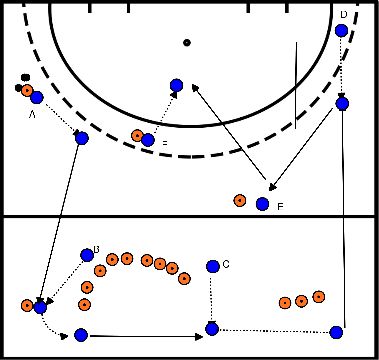
- Numbers opposite each other.
- Increasing distance slowly.
- Pass with 1 hand up on 1 hand teammate.
- Catch with 1 hand and throw back. Continue until ball falls.
- Alternate right/left.
- As soon as this runs.
- Two numbers left and right midcourt.
- Throw with 1 hand, catch, pass with same hand on cutting player for lay-up.
- Left/right alternate.
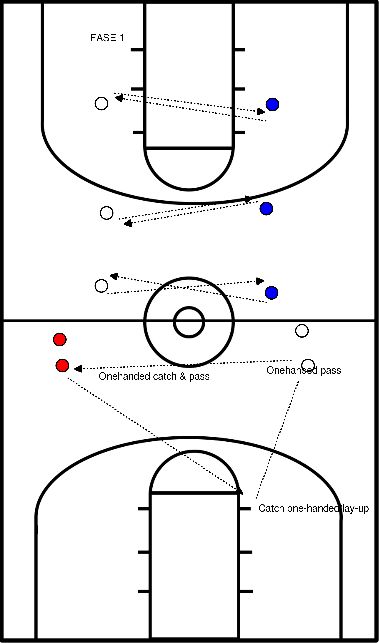
- 1 player represents 4 other players
- 1 player passes the ball and passes it to the freeman
- If the pass departs from the fixed pass, the other ball may leave for the fixed pass
